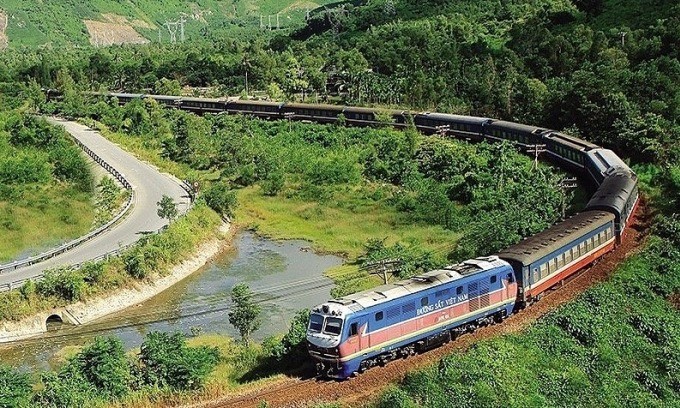 A section of the Vietnam’s north-south railway. (Photo: Lonely Planet) A section of the Vietnam’s north-south railway. (Photo: Lonely Planet) |
B: Thank you, Mr. Thomas, for tuning in to VOV. We hope to receive more feedback from you. Our program is also available on the internet at vovworld.vn and the VOV Media app.
A: In his correspondence to VOV this week, Karuna Kanta Pal of India asked about the train services in Vietnam.
B: Well, thank you for your interest in our program. If you visit Vietnam, voyaging on a train to check out popular tourist destinations will be an unforgettable experience.
 A Da Nang-Quy Nhon train runs through forests in central Vietnam. Photo courtesy of The Vietage A Da Nang-Quy Nhon train runs through forests in central Vietnam. Photo courtesy of The Vietage |
A: The British travel guide Lonely Planet has named the Reunification Express, or Vietnam’s north-south railway, one of the most incredible rail journey’s in the world.
B: The railway stretches for more than 1,700 kilometers between the country’s two largest cities - Hanoi and Ho Chi Minh City - over the course of two days.
A: Lonely Planet said, “Some railways rattle through historic cities; others swoosh beside spectacular coastlines. A few have an epic history, and one or two are remarkable for the colorful characters onboard. The Reunification Express line fulfills all these criteria.”
B: The site also stressed that travelers cannot find a more atmospheric way to travel between Vietnam’s twin metropolises and there’s no better way of exploring all the glories in between.
A: Last year, the US travel site The Points Guy named a train ride called The Vietage through central Vietnam between Da Nang and Quy Nhon cities among the world's seven most luxurious.
 A bar lounge inside the train. Photo courtesy of the Vietage A bar lounge inside the train. Photo courtesy of the Vietage |
B: Launched by Anantara Hotels in 2020, the six-hour train ride runs daily between Anantara Hoi An Resort and the Anantara Quy Nhon Villas, it carries no more than 12 passengers through popular tourist hotspots in Da Nang, Hoi An, Quang Ngai and Quy Nhon in central Vietnam.
A: The train has six cabins, each with two seats close to the windows, offering passengers onboard views of the green rice fields, mountains and the coastline of central Vietnam.
B: Tickets for the 323-kilometer (200-mile) journey cost 350 USD per person one-way, including a complimentary three-course French meal with Vietnamese influences, free flowing wine and beer, plus a head and shoulder massage.
A: The journey allows passengers to sit and enjoy romantic scenery and rural landscapes along coastal towns in the central region, including the former imperial capital of Hue, the Da Nang City Port which was initially built in the French colonial period, and the ancient town of Hoi An.
B: In 2021, CNN named The Vietage train among Asia's six most amazing journeys. It says "Onboard, marble tables, rattan screens and private booths evoke the romance of vintage rail travel."
A: This week, Bidhan Chandra Sanyal of India sent us a story about World Music Day which is celebrated on June 21.
B: Thank you, Mr. Sanyal, for sending us such a beautiful story about the event. Music has no boundaries. It is a bridge connecting people around the world. In VOV’s English service, we have 6 thematic music programs a week: Melody of the Homeland introducing songs about Vietnam, its land and people, Vietnamese composers and Vietnamese singers; Music ON introduces contemporary Vietnamese music, BzB Music Corner featuring international songs; the Selector featuring British songs; and World Music Traveler delving into music genres of difference countries; and Classic in the Air.
A: In addition, between segments of our program, we offer various genres of music, artists and composers. We hope that you will continue tune in to our programs and enjoy the music.
B: This week, VOV received more than 360 emails, letters and phone calls from listeners of 36 countries and territories. Many listeners shared their interests in Vietnamese music and asked about the national song of Vietnam and its author.
A: Welll, the National Anthem of Vietnam is “Tiến Quân Ca” or "Marching Song", also known as the "Army March" or the "Song of Advancing Soldiers”, composed by Van Cao in 1944.
B: “Marching Song” was published in papers in November the same year with lithographs by Văn Cao. On August 17, 1945, the song was sung for the first time at a rally of civil servants in Hanoi.
A: On August 13, 1945, President Ho Chi Minh approved “Marching Song” to be officially recognized as the anthem of the Democratic Republic of Vietnam.
B: On September 2, 1945, “Marching Song” was officially performed on the day of the Declaration of Independence at Ba Dinh Square by the Liberation Army band.
A: In 1946, the 1st National Assembly officially recognized "Marching Song" as the national anthem. Article 3 of the first Constitution of the Democratic Republic of Vietnam speaks directly of the song.
B: On July 2, 1976, following the reunification of Vietnam, "Marching song " was chosen as the national anthem of the Socialist Republic of Vietnam.
A: The author of the song, Van Cao was born in the northern coastal city of Hai Phong in 1923 and was initially known for romantic ballads.
B: In 1942, he joined the revolutionary movement and began composing songs about the nation and soldiers.
A: His popular songs include “Bac Son - A Guerrilla Centre During the War against the French Invaders,” “Vietnamese Soldiers,” “Vietnamese Air Force,” and “The Lo River Epic.” Van Cao was also a successful poet and painter.
B: He was one of the most influential songwriters in Vietnam in the 20th century. His love songs still inspire contemporary Vietnamese pop singers. His music and lyrics were touched with sadness, but a pure, innocent sadness without being maudlin. Van Cao combined his romantic streak with his patriotism to write revolutionary songs that called on young people to fight the enemy.
A: Van Cao was a talented, sensitive man. He had aspirations in multiple areas including music, poetry and painting. His poems explore the inner world of man; his paintings, particularly his illustrations, have a style of their own. But whenever we talk about Van Cao, we talk of his music first.
B: Van Cao passed away in 1995, but his accomplishments will live on for generations.
A: Next, we’d like to acknowledge a letter from Yamada Yasuhisa of Japan, who wrote: “I have never been to Vietnam. I only know about Vietnam through some articles. I love to explore your country via radio rather than searching for it on the internet. I really hope to listen to more programs about Vietnam, its landscapes, culture, cuisine and people.”
B: Many other listeners praised VOV’s stories about Vietnam’s cuisine and tourism.
A: Antonio Argolo Silva Neto of Brazil wrote: “I’m always interested in VOV programs. I admire the Vietnamese traditional culture. That’s why I love all articles and images depicting Vietnam covered by the Voice of Vietnam which have helped us know more about your country.”
A: Thank you all for your interest in VOV, for sharing your love with our country, and for sending us your feedback. We hope to see you in Vietnam.
B: We welcome your feedback at: English Service, VOVWorld, the Voice of Vietnam, 45 Ba Trieu street, Hanoi, Vietnam. Or you can email us at: englishsection@vov.vn. You’re invited to visit us online at vovworld.vn, where you can hear both live and recorded programs.
A: Check out our VOV Media App, available on both the IOS and Android platform, to hear our broadcasts. We look forward to your feedback on the mobile version of vovworld.vn. Once again, thank you all for listening. Goodbye!